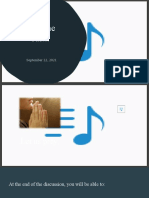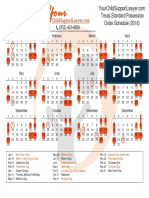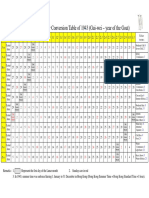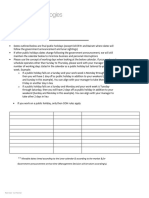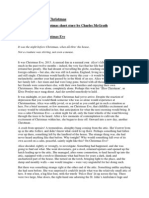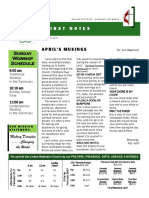0 ratings0% found this document useful (0 votes)
26 viewsPrepositions of Time
Prepositions of Time
Uploaded by
ElvisThe document discusses the use of the prepositions "at", "on", and "in" with regards to time and place.
For time, "at" is used for specific clock times and points in the day, "in" refers to longer periods like months or seasons, and "on" is used with days of the week and dates.
For place, "at" indicates specific points or locations, "on" describes positions on surfaces or along lines like streets, and "in" refers to larger surrounding areas like cities, buildings, or containers.
An overall pattern emerges where "at" is one-dimensional for time or space, "on" is two-dimensional relating to surfaces
Copyright:
© All Rights Reserved
Available Formats
Download as DOCX, PDF, TXT or read online from Scribd
Prepositions of Time
Prepositions of Time
Uploaded by
Elvis0 ratings0% found this document useful (0 votes)
26 views4 pagesThe document discusses the use of the prepositions "at", "on", and "in" with regards to time and place.
For time, "at" is used for specific clock times and points in the day, "in" refers to longer periods like months or seasons, and "on" is used with days of the week and dates.
For place, "at" indicates specific points or locations, "on" describes positions on surfaces or along lines like streets, and "in" refers to larger surrounding areas like cities, buildings, or containers.
An overall pattern emerges where "at" is one-dimensional for time or space, "on" is two-dimensional relating to surfaces
Original Description:
Preposiciones de tiempo
Copyright
© © All Rights Reserved
Available Formats
DOCX, PDF, TXT or read online from Scribd
Share this document
Did you find this document useful?
Is this content inappropriate?
The document discusses the use of the prepositions "at", "on", and "in" with regards to time and place.
For time, "at" is used for specific clock times and points in the day, "in" refers to longer periods like months or seasons, and "on" is used with days of the week and dates.
For place, "at" indicates specific points or locations, "on" describes positions on surfaces or along lines like streets, and "in" refers to larger surrounding areas like cities, buildings, or containers.
An overall pattern emerges where "at" is one-dimensional for time or space, "on" is two-dimensional relating to surfaces
Copyright:
© All Rights Reserved
Available Formats
Download as DOCX, PDF, TXT or read online from Scribd
Download as docx, pdf, or txt
0 ratings0% found this document useful (0 votes)
26 views4 pagesPrepositions of Time
Prepositions of Time
Uploaded by
ElvisThe document discusses the use of the prepositions "at", "on", and "in" with regards to time and place.
For time, "at" is used for specific clock times and points in the day, "in" refers to longer periods like months or seasons, and "on" is used with days of the week and dates.
For place, "at" indicates specific points or locations, "on" describes positions on surfaces or along lines like streets, and "in" refers to larger surrounding areas like cities, buildings, or containers.
An overall pattern emerges where "at" is one-dimensional for time or space, "on" is two-dimensional relating to surfaces
Copyright:
© All Rights Reserved
Available Formats
Download as DOCX, PDF, TXT or read online from Scribd
Download as docx, pdf, or txt
You are on page 1of 4
PREPOSITIONS OF TIME in, on, at
The preposition AT is used in the following descriptions of time:
With clock times:
My last train We left at The meeting starts
leaves at 10:30. midnight. at two thirty.
With specific times of day, or mealtimes:
I like to read the
He doesnt like Ill go shopping
children a story at
driving at night. at lunchtime.
bedtime.
With festivals:
Are you going
home at
Christmas/Easter?
In certain fixed expressions which refer to specific points in time:
Are you leaving at Hes unavailable We arrived at the
the weekend?** at present. same time.
I finish the
Shes working at
course at the end of
the moment.
April.
**Note that in American English, on the weekend is the correct form.
The preposition IN is used in the following descriptions of time:
With months, years, seasons, and longer periods of time:
I was born in The pool is The play is set in
1965. closed in winter. the Middle Ages.
Were going to He was famous Theyve done work
visit them in May. in the 1980s. for me in the past.
With periods of time during the day:
She usually has a
Hes leaving in the I tried to work in
sleep in the
morning. the evening.
afternoon(s).
To describe the amount of time needed to do something:
You can travel They managed to
there and back in a finish the job in two
day. weeks.
To indicate when something will happen in the future:
Shell be ready in Hes gone away but hell
a few minutes. be back in a couple of days.
The preposition ON is used in the following descriptions of time:
With days of the week, and parts of days of the week:
Were going to the
Ill see you on She usually
theatre on Wednesday
Friday. works on Mondays. evening.
Note that in spoken English, on is often omitted in this context, e.g.: Ill see
you Friday.
With dates:
The interview is He was born on
on 29th April. February 14th 1995.
With special days:
She was born on We move house I have an exam on
Valentines day. on Christmas Eve. my birthday.
If we examine these different aspects of usage for the three prepositions, a
general pattern emerges. At is generally used in reference to specific times on
the clock or points of time in the day. In generally refers to longer periods of
time, several hours or more. On is used with dates and named days of the week.
PREPOSITIONS OF PLACE in, on, at
The preposition AT is used in the following descriptions of place/position:
With specific places/points in space:
I had a cup of
She kept the horse Theres a man at
coffee at Helens
at a nearby farm. the door.
(house/flat).
I saw her
Angies still at The index is at the
standing at the bus
home. back of the book.
stop.
Ill meet you at Turn right at the Write your name at
reception. traffic lights. the top of each page.
With public places and shops:
Janes at the Shall I meet you I studied German at
dentist/hairdresser. at the station? college/school/university.
We bought some
bread at the
supermarket.
With addresses:
They live at 70,
Duncombe Place.
With events:
I met her at last years
conference. She wasnt at Simons
party.
The preposition ON is used in the following descriptions of place/position:
With surfaces, or things that can be thought of as surfaces:
Write the number
The letter is on my Youve got a dirty
down on a piece of
desk. mark on your jumper.
paper.
There was a
He had a large She placed her
beautiful painting on
spot on his nose. hand on my shoulder.
the wall.
The toy
department is on the
first floor.
With roads/streets, or other things that can be thought of as a line, e.g.:
rivers:
The bank is on the Koblenz is on the Bournemouth is on
corner of Kings Street. Rhine. the south coast.
Its the second
turning on the left.
The preposition IN is used in the following descriptions of place/position:
With geographical regions:
Driving in France Orgiva is a very
is very small village in the
straightforward. mountains.
With cities, towns and larger areas:
They were She works
Do you like living
having a picnic in the somewhere in the toy
in Nottingham?
park. department.
With buildings/rooms and places that can be thought of as surrounding a
person or object on all sides:
Theres a wedding
Ive left my bag in
Can you take a seat
in the church this in the waiting room
the office. afternoon. please?
Lots of people
were swimming in the
lake
With containers:
Theres fresh milk I think Ive got a The money is in the
in the fridge. tissue in my pocket. top drawer of my desk.
With liquids and other substances, to show what they contain:
Do you take milk I can taste garlic Theres a lot of fat
in your coffee? in this sauce. in cheese and butter.
A general pattern again emerges if we consider these different aspects of usage. We can think
of at as one-dimensional, referring to a specific place or position in space. On is two
dimensional, referring to the position of something in relation to a surface. In is by contrast
three-dimensional, referring to the position of something in relation to the things that
surround it. Thinking of the prepositions in these terms helps us explain certain facts. For
instance, in is generally used for larger places and at for smaller, more specific places.
You might also like
- Magickal Herb AttributesDocument39 pagesMagickal Herb Attributesnovasmagic100% (5)
- Gregorian Chant Guide SaulnierDocument128 pagesGregorian Chant Guide SaulnierSilvestreBoulez100% (4)
- Prepositions of TimeDocument3 pagesPrepositions of TimeElvisNo ratings yet
- Adverbs Place / TimeDocument9 pagesAdverbs Place / Timemohammad515No ratings yet
- Prepositions of Time and PlaceDocument6 pagesPrepositions of Time and Placehem777No ratings yet
- PrepositionsDocument11 pagesPrepositionsMonika LangngagNo ratings yet
- Prepositions - In, On, atDocument7 pagesPrepositions - In, On, atdash21ingNo ratings yet
- Unit 3. GRAMMAR. PrepositionsDocument8 pagesUnit 3. GRAMMAR. PrepositionsAnna BoludaNo ratings yet
- Preposition in On at Place and TimeDocument2 pagesPreposition in On at Place and TimeSlađana ŠepecanovićNo ratings yet
- Lesson Use of In, On, at PrepositionsDocument9 pagesLesson Use of In, On, at PrepositionsGhislain DipamaNo ratings yet
- Prepositions EdatlarDocument23 pagesPrepositions EdatlarsuhakulturNo ratings yet
- PREPOSITION OF TIME and PlaceDocument2 pagesPREPOSITION OF TIME and PlaceTrang Thùy VươngNo ratings yet
- At in On Precise Time Months, Years, Centuries and Long Periods DAYS and DatesDocument4 pagesAt in On Precise Time Months, Years, Centuries and Long Periods DAYS and DatesEleftheria BegetisNo ratings yet
- Prepositions of Place & Time-At-In-OnDocument2 pagesPrepositions of Place & Time-At-In-OnNils CanidoNo ratings yet
- Prepozitii Timp LocDocument5 pagesPrepozitii Timp LocDan IonescuNo ratings yet
- Chap9 PrepositionsDocument23 pagesChap9 PrepositionsAyu MayangsariNo ratings yet
- Prepositions TheoryDocument6 pagesPrepositions TheoryOnline iaprendeNo ratings yet
- Prepositions Are Words That Indicate Relationship Between A Noun or Pronoun and Other Words in A SentenceDocument16 pagesPrepositions Are Words That Indicate Relationship Between A Noun or Pronoun and Other Words in A SentenceSheryl DesilvaNo ratings yet
- Preposition of PlaceDocument19 pagesPreposition of PlaceAna SementeNo ratings yet
- Prepositions in EnglishDocument12 pagesPrepositions in EnglishOmar H. AlmahdawiNo ratings yet
- Eng - B.Tech. Syllabus - TextDocument126 pagesEng - B.Tech. Syllabus - TextManoj ChallaNo ratings yet
- English Classes MaríaDocument7 pagesEnglish Classes MaríaMaría Rivaya MartosNo ratings yet
- PrepositionDocument11 pagesPrepositionAlexandre F. CostaNo ratings yet
- PORTAFOLIO KERLY BAJAÑA 3fDocument40 pagesPORTAFOLIO KERLY BAJAÑA 3fSolange RiofrioNo ratings yet
- English JobDocument8 pagesEnglish JobGeovildo CebolaNo ratings yet
- Grammar Review 11. PrepotisionsDocument7 pagesGrammar Review 11. PrepotisionsLe Ngoc QuangNo ratings yet
- PrepositionDocument6 pagesPrepositionazharNo ratings yet
- Prepositions of PlaceDocument28 pagesPrepositions of PlaceMaia aguirreNo ratings yet
- PREPOSITIONSDocument3 pagesPREPOSITIONSNathalia CondeNo ratings yet
- Prepositions of Time and PlaceDocument16 pagesPrepositions of Time and PlaceWilson Hugo LizanaNo ratings yet
- English Literature Module: Prepositional PhrasesDocument8 pagesEnglish Literature Module: Prepositional PhrasesNadya Ilmi HanifaNo ratings yet
- Básico2 Unit2Document59 pagesBásico2 Unit2ComnavelichNo ratings yet
- Basic TensesDocument10 pagesBasic TensesS Lakshmikanta ReddyNo ratings yet
- Sims - English - EditedDocument36 pagesSims - English - EditedRos Yaj Nivrame100% (2)
- Sir Ehsan Salar's Prepostion-1Document19 pagesSir Ehsan Salar's Prepostion-1sherkhanbalch67No ratings yet
- INTERACTIVE ENGLISH Intonation, Adverbs of Frequency & Prepositions of TimeDocument5 pagesINTERACTIVE ENGLISH Intonation, Adverbs of Frequency & Prepositions of TimeRemedios Abiera BianesNo ratings yet
- Prepositions of Time - At, In, OnDocument3 pagesPrepositions of Time - At, In, OnJunior LeónNo ratings yet
- Time Prepositions OnDocument12 pagesTime Prepositions OnAnandNo ratings yet
- Prepositions in Time PhraseDocument10 pagesPrepositions in Time Phraseaashish.v.s2004No ratings yet
- Avenue, But Not She Lives in 132 Gainsborough Avenue or The Bank Is at Grimshaw Lane?Document7 pagesAvenue, But Not She Lives in 132 Gainsborough Avenue or The Bank Is at Grimshaw Lane?Nico TuscaniNo ratings yet
- Prepositions - FebruaryDocument10 pagesPrepositions - FebruaryiniwdcNo ratings yet
- PrepositionsDocument10 pagesPrepositionsSmd nazeebNo ratings yet
- English Advanced Book by Alex Alejandro JimenezDocument176 pagesEnglish Advanced Book by Alex Alejandro JimenezTanit Alcira Guerra HuarangaNo ratings yet
- Prepositions Modified For New CoursesDocument4 pagesPrepositions Modified For New CoursesjuanchishoyosNo ratings yet
- Delgado Rivera Susana Portfolio 5to ADocument22 pagesDelgado Rivera Susana Portfolio 5to ASILVIA EDITH ESTRADA CAÑIZARESNo ratings yet
- 110 Problematic Prepositions in SPANISHDocument7 pages110 Problematic Prepositions in SPANISHERALON_11100% (1)
- Note On Preposition - PDF (For Post)Document11 pagesNote On Preposition - PDF (For Post)majumderprattasha1No ratings yet
- Prepositions of Time & PlaceDocument10 pagesPrepositions of Time & PlaceLuna SDNo ratings yet
- Anexo Actividades 2Document15 pagesAnexo Actividades 2Mafe EverywhereNo ratings yet
- Using Prepositions IN, ON, AT (General)Document26 pagesUsing Prepositions IN, ON, AT (General)Jen QuitorioNo ratings yet
- TT 2 BHS Inggris (PGSD)Document4 pagesTT 2 BHS Inggris (PGSD)nugroho tenggoNo ratings yet
- Lesson 8Document6 pagesLesson 8api-417830710No ratings yet
- The Prepositions at in On 2Document5 pagesThe Prepositions at in On 2Eric Erik50% (2)
- Ɛ / vs. /æ/ Men vs. Ma'am: Bell, Pen, Check, Rest, and SpellDocument8 pagesƐ / vs. /æ/ Men vs. Ma'am: Bell, Pen, Check, Rest, and SpellMonica CantilloNo ratings yet
- General English 5 - PrepositionDocument10 pagesGeneral English 5 - PrepositionMaryam Alimatil AliyahNo ratings yet
- Me - Past Continuous and Past SimpleDocument5 pagesMe - Past Continuous and Past SimplekjakaNo ratings yet
- Using Prepositions IN, ON, AT (Time)Document27 pagesUsing Prepositions IN, ON, AT (Time)Jen QuitorioNo ratings yet
- PronounDocument25 pagesPronounkumarlavesh469No ratings yet
- Prepositions of Time: IN AT ONDocument10 pagesPrepositions of Time: IN AT ONGualdistrudis Camarena JordánNo ratings yet
- Prepositions of TimeDocument7 pagesPrepositions of TimeNguyên BùiNo ratings yet
- Simple TensesDocument12 pagesSimple TensesHienNo ratings yet
- Master IN, ON, AT - Docx1Document15 pagesMaster IN, ON, AT - Docx1A. GHUZZINo ratings yet
- Christmas Eve Candlelight Service: Saturday, December 24 at 6pmDocument8 pagesChristmas Eve Candlelight Service: Saturday, December 24 at 6pmAnonymous iZuv5BRCNo ratings yet
- PumpkinsawebquestDocument8 pagesPumpkinsawebquestapi-289247247No ratings yet
- ChrirmassDocument1 pageChrirmassRex Jhong DayaNo ratings yet
- Rio de Janeiro CarnivalDocument3 pagesRio de Janeiro CarnivalAntoniolukkuNo ratings yet
- Business English at Work: © 2003 Glencoe/Mcgraw-HillDocument35 pagesBusiness English at Work: © 2003 Glencoe/Mcgraw-HillriomjNo ratings yet
- Easter B1 - C1Document7 pagesEaster B1 - C1mariia.stetsyukNo ratings yet
- Texsa SPO 2018 CalendarDocument1 pageTexsa SPO 2018 CalendarMac-Arthur Pierre-Louis, J.D., M.EdNo ratings yet
- Organic Garden, Japanese Garden and GreenhouseDocument2 pagesOrganic Garden, Japanese Garden and GreenhouseAnaMariaNo ratings yet
- Gregorian-Lunar Calendar Conversion Table of 1943 (Gui-Wei - Year of The Goat)Document1 pageGregorian-Lunar Calendar Conversion Table of 1943 (Gui-Wei - Year of The Goat)Anomali SahamNo ratings yet
- Festivities in PeruDocument2 pagesFestivities in PeruKrishna TorresNo ratings yet
- 2022 DELL Technologies Egypt Official Public HolidaysDocument2 pages2022 DELL Technologies Egypt Official Public HolidaysAhmed AzouzNo ratings yet
- Prelude Introit Opening Hymn Advent Reading: Christian ChurchDocument6 pagesPrelude Introit Opening Hymn Advent Reading: Christian ChurchFrank ShirvinskiNo ratings yet
- Calico Critters Official SiteDocument1 pageCalico Critters Official SiteBianca LozanoNo ratings yet
- Happy Holidays TemplateDocument1 pageHappy Holidays TemplateНиколче МитриќевскиNo ratings yet
- April 2022 Prince of Peace Newsletter 2Document6 pagesApril 2022 Prince of Peace Newsletter 2Olusola TopNo ratings yet
- Valentines Day Outburst FinalDocument4 pagesValentines Day Outburst FinalJannet Herrera ChavezNo ratings yet
- BB Master Index 2018Document70 pagesBB Master Index 2018tmptpaul67% (3)
- Week 24Document1 pageWeek 24stephtrederNo ratings yet
- Present Continuous PracticeDocument1 pagePresent Continuous PracticeAvram Paula-roxanaNo ratings yet
- 2023 Social Media CalendarDocument16 pages2023 Social Media Calendardayana8kingNo ratings yet
- Doctor Who Christmas 2013 - The Night Before ChristmasDocument11 pagesDoctor Who Christmas 2013 - The Night Before Christmasapi-243383892No ratings yet
- England Traditions, Customs and Public HolidaysDocument12 pagesEngland Traditions, Customs and Public HolidaysЮлія Василівна ГунчакNo ratings yet
- Pamisulu Vol.1 Number 1 (2011)Document84 pagesPamisulu Vol.1 Number 1 (2011)sapientiamaterboniNo ratings yet
- First Pages (Sample) From When The Universe Was An IslandDocument9 pagesFirst Pages (Sample) From When The Universe Was An IslandAlexandra EdwardsNo ratings yet
- ) Look at The Picture and CompleteDocument7 pages) Look at The Picture and CompleteJanina JaworskiNo ratings yet
- Easter NotesDocument2 pagesEaster Notespriyanshigoyal0102No ratings yet
- First Notes: April'S MusingsDocument8 pagesFirst Notes: April'S MusingsFirst United Methodist ChurchNo ratings yet

























































